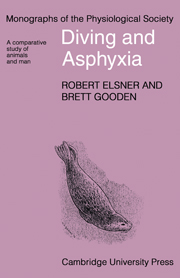7 - Medical implications
Published online by Cambridge University Press: 18 May 2010
Summary
… when the heart beats more languidly, it is impossible to feel the pulse not only in the fingers but also in the wrist and in the temples, as in fainting, in hysterical manifestations, in asphyxia, in the more sickly and in those about to die
(William Harvey, 1628).The relevance of the asphyxial defence response to conditions such as near-drowning and birth asphyxia is clear. In others, such as sudden infant-death, it provides an attractive hypothesis. The diving response has been used recently as a clinical tool for the treatment of certain cardiac arrhythmias and as a simple test of autonomic function. There would appear to be considerable scope for such applications, particularly as they apply to asphyxia and cardiovascular medicine. These considerations may indicate further avenues for investigation into a variety of medical and surgical problems. We suggest that some of these instances in which apnoea, hypoventilation and asphyxia are prominent parts of the clinical syndrome may be better understood by recognition of potential similarities in underlying mechanisms to the phenomena of diving responses. The subject has been reviewed (Angell-James & Daly, 1969b; Daly & Angell-James, 1979; Daly, Angell-James & Elsner, 1979a, b; Gooden, 1982).
Near-drowning
Drowning is a common cause of death, accounting for about 8000 fatalities per year in the USA (Baker, 1954; Boucher, 1962; Modell, 1971). Death from drowning may result from asphyxia alone, in which case little or no water is found in the lungs at autopsy, or from the consequences of inhalation of water combined with asphyxia (Miles, 1962).
- Type
- Chapter
- Information
- Diving and AsphyxiaA Comparative Study of Animals and Man, pp. 115 - 129Publisher: Cambridge University PressPrint publication year: 1983



